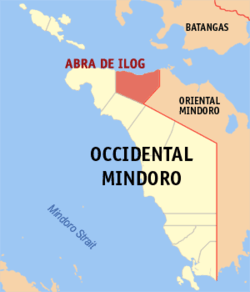Abra de Ilog
| Abra de Ilog | ||
|---|---|---|
| Municipality | ||
| Municipality of Abra de Ilog | ||
|
| ||
| ||
 Map of Occidental Mindoro with Abra de Ilog highlighted | ||
.svg.png) Abra de Ilog Location within the Philippines | ||
| Coordinates: 13°27′N 120°44′E / 13.45°N 120.73°ECoordinates: 13°27′N 120°44′E / 13.45°N 120.73°E | ||
| Country | Philippines | |
| Region | Mimaropa (Region IV-B) | |
| Province | Occidental Mindoro | |
| District | Lone District | |
| Founded | 1902 | |
| Barangays | 10 (see Barangays) | |
| Government [1] | ||
| • Type | Sangguniang Bayan | |
| • Mayor | Maria Gloria M. Constantino | |
| • Electorate | 16,284 voters (2016) | |
| Area [2] | ||
| • Total | 533.70 km2 (206.06 sq mi) | |
| Population (2015 census)[3] | ||
| • Total | 31,306 | |
| • Density | 59/km2 (150/sq mi) | |
| Time zone | UTC+8 (PST) | |
| ZIP code | 5108 | |
| PSGC | 175101000 | |
| IDD : area code | +63 (0)43 | |
| Climate type | Tropical climate | |
| Income class | 2nd municipal income class | |
| Revenue (₱) | 135,705,287.18 (2016) | |
| Native languages |
Iraya Tagalog | |
Abra de Ilog, officially the Municipality of Abra de Ilog, is a 2nd class municipality in the province of Occidental Mindoro, Philippines. According to the 2015 census, it has a population of 31,306 people.[3]
It is classified as partially urban.
Barangays
Abra de Ilog is politically subdivided into 10 barangays. The newest barangay, Santa Maria was created in 2014 from Wawa.
| Barangay | Urban/Rural | Population (2015) |
|---|---|---|
| Armado | rural | 2,136 |
| Balao | rural | 3,347 |
| Cabacao | rural | 5,730 |
| Lumangbayan | rural | 3,527 |
| Poblacion | urban | 2,720 |
| Santa Maria | rural | 1,877 |
| San Vicente | rural | 2,855 |
| Tibag | rural | 2,074 |
| Udalo (Camurong) | rural | 3,944 |
| Wawa | rural | 3,096 |
History
Abra de Ilog was formerly a small settlement founded by Spanish religious missionaries sometime in the early part of the 17th century. According to folk history, its former name was Abre de Ilog. The name was derived from the Spanish verb abrir (to open) and the Tagalog noun ilog (river). Later on, the name evolved into its present name: Abra de Ilog, a Chabacano-like terminology which can be loosely translated as bucana ng ilog, or "opening of the river." This can be attributed to the numerous rivers and creeks that traverses strategic areas of the municipality.
In 1902, during the American Occupation the town was officially organized. Abra de Ilog's first "municipal president" was Rosaleo Miciano. But with the passage of Republic Act No. 1280 (An Act Reducing the Fifteen (15) Municipalities of Occidental Mindoro into Eight (8) Municipalities) on January 4, 1905, Abra de Ilog was made a barrio of the Municipality of Mamburao.
Five years later, in 1910, Abra de Ilog regained its status as a municipality. On June 13, 1915, the government under US Governor-General Francis Burton Harrison approved Rep. Act 505 creating the "New Province of Occidental Mindoro". This new province comprised the municipalities of Abra de Ilog, Looc, Lubang, Mamburao (now the capital of Occidental Mindoro), Paluan, Sablayan, San José and Santa Cruz.
Demographics
| Population census of Abra de Ilog | |||||||||||||||||||||||||||||||||||||||||||||||||
|---|---|---|---|---|---|---|---|---|---|---|---|---|---|---|---|---|---|---|---|---|---|---|---|---|---|---|---|---|---|---|---|---|---|---|---|---|---|---|---|---|---|---|---|---|---|---|---|---|---|
|
| ||||||||||||||||||||||||||||||||||||||||||||||||
| Source: Philippine Statistics Authority[3] [4] [5] [6] | |||||||||||||||||||||||||||||||||||||||||||||||||
References
- ↑ "Municipality". Quezon City, Philippines: Department of the Interior and Local Government. Retrieved 31 May 2013.
- ↑ "Province: Occidental Mindoro". PSGC Interactive. Quezon City, Philippines: Philippine Statistics Authority. Retrieved 12 November 2016.
- 1 2 3 Census of Population (2015). "Region IV-B (Mimaropa)". Total Population by Province, City, Municipality and Barangay. PSA. Retrieved 20 June 2016.
- ↑ Census of Population and Housing (2010). "Region IV-B (Mimaropa)". Total Population by Province, City, Municipality and Barangay. NSO. Retrieved 29 June 2016.
- ↑ Censuses of Population (1903–2007). "Region IV-B (Mimaropa)". Table 1. Population Enumerated in Various Censuses by Province/Highly Urbanized City: 1903 to 2007. NSO.
- ↑ "Province of Occidental Mindoro". Municipality Population Data. Local Water Utilities Administration Research Division. Retrieved 17 December 2016.
External links
| Wikimedia Commons has media related to Abra de Ilog. |
